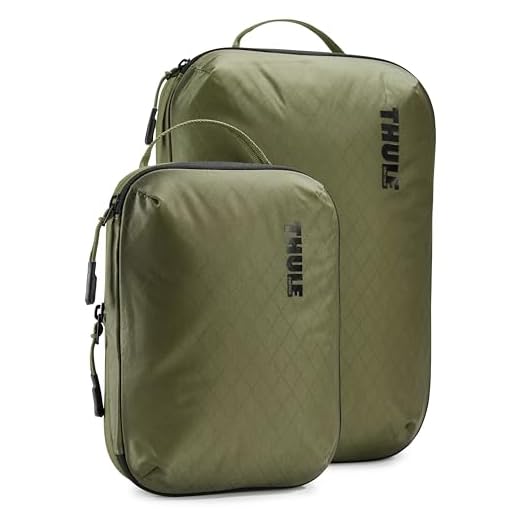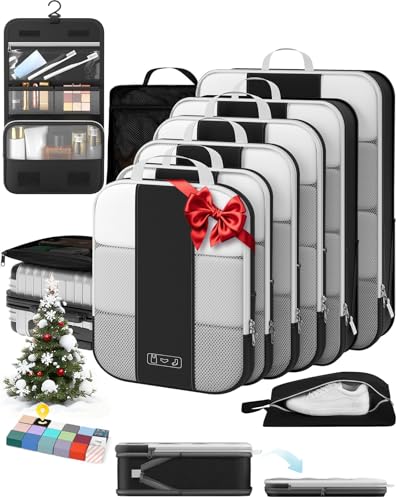



Rolling is a proven method for space-saving. Fold the neckline inward and then roll from the bottom up, securing the sleeves alongside the body. This technique minimizes creasing and maximizes available space.
Utilizing packing cubes enhances organization. Group similar attire together, placing heavier items at the bottom for weight distribution. This method keeps everything in its place, allowing for quick access during travels.
Consider layering options to save additional space. Place lighter garments inside heavier pieces or utilize them as cushioning for fragile items. This not only optimizes the area but also protects delicate items during transit.
Always include a travel-sized steamer in your essentials. Wrinkles can be easily removed upon arrival, saving time and effort for events or meetings. This ensures your appearance remains sharp regardless of travel conditions.
Finally, keep a checklist to ensure all necessary items are packed without doubling up. This will streamline the packing process and ensure a smooth travel experience.
Maximizing Space for Formal Tops
Begin with folding each piece neatly. Lay the garment face down, fold the sleeves inward, and then bring the bottom up to meet the collar, creating a rectangular shape. This method minimizes wrinkles and enhances space efficiency.
Utilize packing cubes or compression bags to further streamline organization. These tools not only keep garments compact but also allow for easy access without disrupting the rest of your contents.
Consider rolling instead of folding for casual styles. This method can also save space while providing a unique approach to minimize crease formation. Pair tightly rolled items with softer fabrics that resist wrinkling.
Position denser articles, like trousers, at the base of your bag. Layer lighter options on top, ensuring an even distribution of weight. Avoid overstuffing, as this can lead to unnecessary creasing.
Incorporate any empty spaces in your travel gear effectively. Use gaps around shoes or other accessories to tuck smaller items, such as ties or belts, ensuring every inch of your travel case is utilized.
Prioritize your destination’s climate when selecting pieces to bring along. Opt for lighter materials in warmer areas to reduce bulk and keep the load manageable.
Lastly, don’t forget to include a wrinkle-release spray in your travel kit. A quick spritz can refresh items after unpacking, ensuring every piece looks impeccable upon arrival.
Choosing the Right Folding Technique
Select a folding method that minimizes wrinkles and maximizes space. Here are several effective approaches:
Classic Fold
This technique is ideal for button-up styles. Follow these steps:
- Button all buttons to maintain the shirt’s shape.
- Lay the shirt face down on a flat surface.
- Fold each sleeve inward, forming a rectangle.
- Bring the bottom hem up to meet the collar, then fold in half.
Roll Technique
Perfect for casual or knit tops, rolling reduces creases and saves space:
- Lay the shirt face up.
- Fold the sleeves inward.
- Starting at the bottom, tightly roll the shirt towards the collar.
- Secure the roll with a rubber band or strap to keep it together.
Choosing the right method can significantly impact packing efficiency. For those packing sports gear, consider lightweight options like the best duffel bag for gym to enhance organization.
Utilizing Packing Cubes for Organization
Incorporate packing cubes to streamline the arrangement of garments for travel. These lightweight containers promote compartmentalization, allowing for a focused approach to storing items.
Designate separate cubes for different categories, such as formal and casual attire, ensuring quick access without rummaging through a pile. This can save time at your destination, as you can easily pull out a single cube without disturbing the contents of others.
Consider the following tips for effective utilization:
| Tip | Description |
|---|---|
| Size Variation | Select cubes of various sizes to accommodate items like light blouses and bulkier sweaters. This maximizes space efficiency. |
| Color Coding | Employ different colors for easy identification. Assign specific hues for particular styles or outfits. |
| Rolling Technique | Utilize the rolling method for placement within each cube. This minimizes creasing and maximizes space utilization. |
| Layering Strategy | Position heavier fabrics at the bottom of cubes, with lighter pieces above. This prevents shifting during transit. |
| Compression Options | Some packing cubes come with compression features to reduce volume. Consider these for longer trips. |
Implementing packing cubes can transform the packing experience, ensuring garments remain organized, accessible, and in optimal condition throughout the trip.
Maximizing Space with Rolling Method
Rolling garments instead of folding is a superior technique that optimizes space while minimizing creases. Begin by laying a garment flat on a clean surface. Smooth out any wrinkles to ensure an even roll. Start at the collar or the top of the item and tightly roll down to the hem. This method not only conserves room but also allows for the creation of neat bundles.
Tips for Effective Rolling
For added versatility, consider rolling similar items together. Group lightweight tops to create compact cylinders that can be easily stacked. Utilize any remaining gaps in your travel case, filling them with rolled essentials to achieve maximum efficiency. Additionally, layering delicate fabrics with sturdier items can provide protection against crushing.
Storage Considerations
Utilize compression bags if available. They reduce the overall bulk of rolled items, offering additional room for other belongings. When you reach your destination, simply unroll your attire and hang them up. This method preserves the organization and presentation of your clothing, making them travel-friendly and accessible.
Avoiding Wrinkles with Proper Packing Order
Begin by placing heavier items, such as shoes and toiletries, at the bottom of your bag. This foundation creates stability and prevents shifting during transit.
Layering Tactics
Layer clothing strategically, starting with bulky pieces. Fold items like jackets and sweaters flat, then add lighter garments on top, ensuring that delicate fabrics are shielded from heavy ones. This method minimizes pressure on softer materials, reducing the likelihood of creasing.
Placement of Accessories
Utilize gaps with smaller items such as belts, ties, or rolled-up socks. These can fill voids and act as support, preventing movement of larger articles. Consider wrapping fragile accessories in soft materials to protect them and your garments.
- Always check the order before sealing your bag.
- Avoid overstuffing; a snug fit is preferred to a tight one.
- For an additional layer of protection, consider packing a lightweight garment bag around delicate pieces.
By implementing these meticulous layering strategies, along with your packing order, you can significantly reduce the chances of encountering unsightly creases. For those interested in maintaining the condition of various materials beyond clothing, explore options such as best pressure washer for house siding for exceptional results.
Tips for Selecting the Best Fabric Shirts
Choose lightweight materials like cotton or linen for breathability and comfort during travel.
Avoid heavy fabrics, such as denim or thick wool, as they take up more space and can add weight to your pack.
Opt for wrinkle-resistant blends, which can save time on ironing and ensure a polished appearance upon arrival.
Look for moisture-wicking properties in fabrics, which will help keep you dry and comfortable in various climates.
Select shirts with versatile designs, allowing for easy mixing and matching with other items in your collection.
Consider the durability of the fabric, ensuring it can withstand repeated washing and wear while maintaining its shape.
Check for colorfastness to prevent fading during travel, especially for those instances where you may need to wash items on the go.
Investigate the availability of anti-odor materials, beneficial for longer trips without frequent laundering options.








